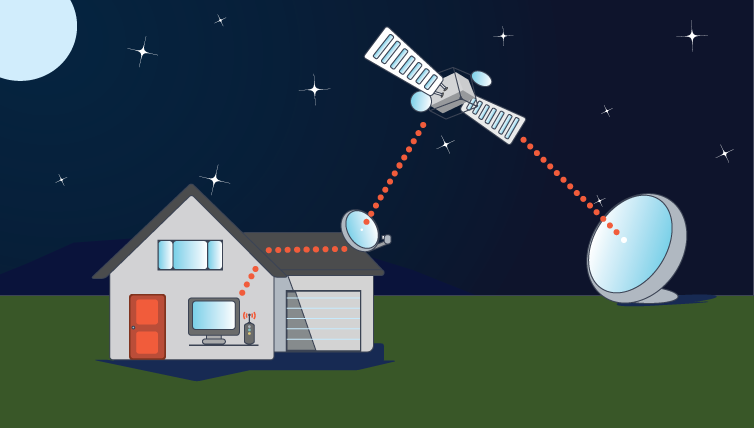Satellite internet now has speeds up to 100–150Mbps if you go with Viasat or HughesNet. That’s pretty fast if you consider most cable and DSL internet plans offer similar speeds.
Satellite internet used to be extremely slow, with download speeds of approximately 750 Kbps. But advancements in technology and new satellites have increased speeds.
You likely won’t notice any difference in how quickly you can do things online with satellite versus how quickly you could do them with cable or DSL. Unless you’re gaming, satellite’s high latency likely won’t affect you.
Latency is the time it takes for data to be sent and received. In the case of satellite internet, it’s the time it takes for information to go from your device to your satellite dish, to your provider’s orbiting satellite, to a separate satellite dish at your ISP, and back again.
As you can see, that’s a lot of steps. And latency has long been a strike against satellite internet.
Latency is higher with satellite internet than it is for cable, DSL, and fiber internet. Cable, DSL, and fiber internet have latency in the 20–50 millisecond (ms) range, while satellite internet ranges can be close to 600 ms.
Because satellites are positioned 22,000 miles above the earth, satellite internet data just has a long way to travel. It’s also why we basically never recommend satellite internet over other types like cable. But if you live in the country or an area without better internet options, satellite might be your best (and sometimes only) choice.
The most obvious effect of latency is on gaming. Gaming that requires ultra-quick responses, like first-person shooters (FPS), just doesn’t work very well with satellite internet. If you choose satellite internet, you might have to say goodbye to League of Legends.
But other online activities, like web browsing, emailing, and photo sharing, won’t be affected by latency much at all.
While it’s true that severe thunderstorms, heavy snow, or blizzards can interrupt satellite transmission temporarily, the problem isn’t as significant as some might lead you to think.
Storm-related interruptions are commonly called “rain fade,” and the signal is restored as soon as the storm passes. You can also remove heavy accumulations of snow from around the satellite dish to restore communications.
In contrast, a heavy thunderstorm with fallen trees or other extreme weather with similar effects could disable cable or DSL for days. Again, most satellite internet customers live in rural areas without access to DSL or cable, so even with rain fade, satellite internet is preferable to alternative, slower means of internet service (like dial-up internet).
Compared to DSL, cable, and fiber internet, satellite is relatively expensive. But its monthly costs have decreased over the years, making it a somewhat more affordable option. (Especially if you have no other internet providers to choose from.)
Nowadays, you can get a Viasat internet plan starting at $70 a month, or a Hughesnet plan starting at $49.99 a month.




